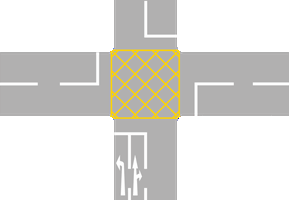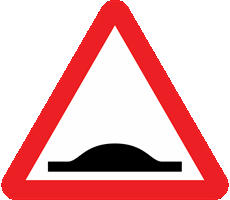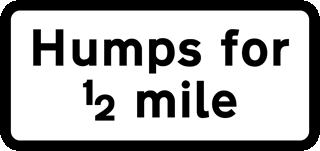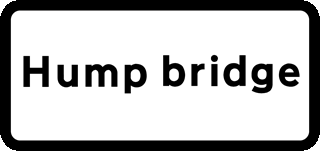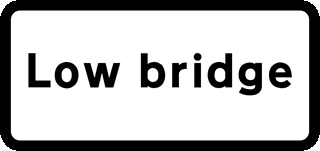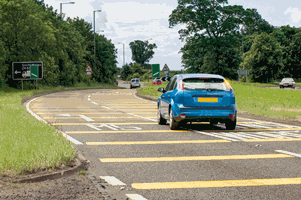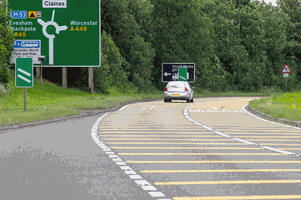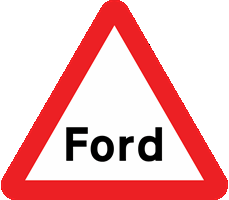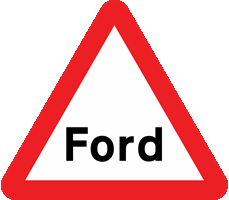There are 51 Vehicle Handling Theory Test questions. You must get 86% (44 out of 51) to pass the test. You may review answers after each question by clicking the 'check answer' button or you can wait until the end of the test for your final score. Good luck!
Test Quick View
Click on an answer to view the correct choice along with the explanation.
Correct Answer: D
Explanation: You may pass slower vehicles on their left while travelling along a one-way street. Be aware of drivers who may need to change lanes and may not expect faster traffic passing on their left.
Explanation: You may pass slower vehicles on their left while travelling along a one-way street. Be aware of drivers who may need to change lanes and may not expect faster traffic passing on their left.
2. You're travelling in very heavy rain. How is this likely to affect your overall stopping distance?
Mark one answer
B
C
D
Correct Answer: A
Explanation: The road will be very wet and spray from other vehicles will reduce your visibility. Tyre grip will also be reduced, increasing your stopping distance. You should at least double your separation distance.
Explanation: The road will be very wet and spray from other vehicles will reduce your visibility. Tyre grip will also be reduced, increasing your stopping distance. You should at least double your separation distance.
Correct Answer: A
Explanation: Don't overtake if there's a possibility of a road junction, bend or brow of a bridge or hill ahead. There are many hazards that are difficult to see in the dark. Only overtake if you're certain that the road ahead is clear. Don't take a chance.
Explanation: Don't overtake if there's a possibility of a road junction, bend or brow of a bridge or hill ahead. There are many hazards that are difficult to see in the dark. Only overtake if you're certain that the road ahead is clear. Don't take a chance.
Correct Answer: C
Explanation: The purpose of a box junction is to keep the junction clear by preventing vehicles from stopping in the path of crossing traffic. You mustn't enter a box junction unless your exit is clear. However, you may enter the box and wait if you want to turn right and are only prevented from doing so by oncoming traffic.
Explanation: The purpose of a box junction is to keep the junction clear by preventing vehicles from stopping in the path of crossing traffic. You mustn't enter a box junction unless your exit is clear. However, you may enter the box and wait if you want to turn right and are only prevented from doing so by oncoming traffic.
Correct Answer: A
Explanation: Road humps are used to slow down traffic.They're found in places where there are often pedestrians, such as
- shopping areas
- near schools
- residential areas.
Watch out for people close to the kerb or crossing the road.
Explanation: Road humps are used to slow down traffic.They're found in places where there are often pedestrians, such as
- shopping areas
- near schools
- residential areas.
Watch out for people close to the kerb or crossing the road.
Correct Answer: C
Explanation: Traffic-calming measures make the roads safer for vulnerable road users, such as cyclists, pedestrians and children. These can be designed as chicanes, road humps or other obstacles that encourage drivers and riders to slow down.
Explanation: Traffic-calming measures make the roads safer for vulnerable road users, such as cyclists, pedestrians and children. These can be designed as chicanes, road humps or other obstacles that encourage drivers and riders to slow down.
7. You're on a motorway in fog. The left-hand edge of the motorway can be identified by reflective studs. What colour are they?
Mark one answer

B
C
D
Correct Answer: C
Explanation: Be especially careful if you're on a motorway in fog. Reflective studs are there to help you in poor visibility. Different colours are used so that you'll know which lane you're in. These are
- red on the left-hand edge of the carriageway
- white between lanes
- amber on the right-hand edge of the carriageway
- green between the carriageway and slip roads
Explanation: Be especially careful if you're on a motorway in fog. Reflective studs are there to help you in poor visibility. Different colours are used so that you'll know which lane you're in. These are
- red on the left-hand edge of the carriageway
- white between lanes
- amber on the right-hand edge of the carriageway
- green between the carriageway and slip roads
Correct Answer: A
Explanation: A rumble device consists of raised markings or strips across the road, designed to give drivers an audible, visual and tactile warning. These devices are used in various locations, including in the line separating the hard shoulder and the left-hand lane on the motorway and on the approach to some hazards, to alert drivers to the need to slow down.
Explanation: A rumble device consists of raised markings or strips across the road, designed to give drivers an audible, visual and tactile warning. These devices are used in various locations, including in the line separating the hard shoulder and the left-hand lane on the motorway and on the approach to some hazards, to alert drivers to the need to slow down.
Correct Answer: D
Explanation: If you're planning to make a journey when it's foggy, listen to the weather reports. If visibility is very poor, avoid making unnecessary journeys. If you do travel, leave plenty of time - and if someone is waiting for you to arrive, let them know that your journey will take longer than normal. This will also take off any pressure you may feel to rush.
Explanation: If you're planning to make a journey when it's foggy, listen to the weather reports. If visibility is very poor, avoid making unnecessary journeys. If you do travel, leave plenty of time - and if someone is waiting for you to arrive, let them know that your journey will take longer than normal. This will also take off any pressure you may feel to rush.
Correct Answer: B
Explanation: To prevent your lights from dazzling the driver of the car in front, wait until you've passed them before switching to full beam.
Explanation: To prevent your lights from dazzling the driver of the car in front, wait until you've passed them before switching to full beam.
11. You're travelling on a road that has speed humps. What should you do when the driver in front is travelling more slowly than you?
Mark one answer
B
C
D
Correct Answer: C
Explanation: Be patient and stay behind the car in front. You shouldn't normally overtake other vehicles in areas subject to traffic calming. If you overtake here, you may easily exceed the speed limit, defeating the purpose of the traffic-calming measures.
Explanation: Be patient and stay behind the car in front. You shouldn't normally overtake other vehicles in areas subject to traffic calming. If you overtake here, you may easily exceed the speed limit, defeating the purpose of the traffic-calming measures.
Correct Answer: B
Explanation: These lines may be painted on the road on the approach to a roundabout, a village or a particular hazard. The lines are raised and painted yellow, and their purpose is to make you aware of your speed. Reduce your speed in good time so that you avoid having to brake harshly over the last few metres before reaching the junction.
Explanation: These lines may be painted on the road on the approach to a roundabout, a village or a particular hazard. The lines are raised and painted yellow, and their purpose is to make you aware of your speed. Reduce your speed in good time so that you avoid having to brake harshly over the last few metres before reaching the junction.
Correct Answer: A
Explanation: Trams may run on roads used by other vehicles and pedestrians. The section of road used by trams is known as the reserved area and should be kept clear. It usually has a different surface, edged with white lane markings.
Explanation: Trams may run on roads used by other vehicles and pedestrians. The section of road used by trams is known as the reserved area and should be kept clear. It usually has a different surface, edged with white lane markings.
B
C
D
Correct Answer: C
Explanation: Take care when using single-track roads. It can be difficult to see around bends, because of hedges or fences, so expect to meet oncoming vehicles. Drive carefully and be ready to pull into or stop opposite a passing place, where you can pass each other safely.
Explanation: Take care when using single-track roads. It can be difficult to see around bends, because of hedges or fences, so expect to meet oncoming vehicles. Drive carefully and be ready to pull into or stop opposite a passing place, where you can pass each other safely.
B
C
D
Correct Answer: D
Explanation: Other drivers or riders may have to change course due to the size or characteristics of their vehicle. Understanding this will help you to anticipate their actions. Motorcyclists and cyclists will be checking the road ahead for uneven or slippery surfaces, especially in wet weather. They may need to move across their lane to avoid surface hazards such as potholes and drain covers.
Explanation: Other drivers or riders may have to change course due to the size or characteristics of their vehicle. Understanding this will help you to anticipate their actions. Motorcyclists and cyclists will be checking the road ahead for uneven or slippery surfaces, especially in wet weather. They may need to move across their lane to avoid surface hazards such as potholes and drain covers.
Correct Answer: D
Explanation: A ford is a crossing over a stream that's shallow enough to drive or ride through. After you've gone through a ford or deep puddle, your brakes will be wet and they won't work as well as usual. To dry them out, apply a light brake pressure while moving slowly. Don't travel at normal speeds until you're sure your brakes are working properly again.
Explanation: A ford is a crossing over a stream that's shallow enough to drive or ride through. After you've gone through a ford or deep puddle, your brakes will be wet and they won't work as well as usual. To dry them out, apply a light brake pressure while moving slowly. Don't travel at normal speeds until you're sure your brakes are working properly again.
Correct Answer: A
Explanation: You won't be able to see as far ahead in fog as you can on a clear day. You'll need to reduce your speed so that, if a hazard looms out of the fog, you have the time and space to take avoiding action. Travelling in fog is hazardous. If you can, try to delay your journey until it has cleared.
Explanation: You won't be able to see as far ahead in fog as you can on a clear day. You'll need to reduce your speed so that, if a hazard looms out of the fog, you have the time and space to take avoiding action. Travelling in fog is hazardous. If you can, try to delay your journey until it has cleared.
Correct Answer: B
Explanation: The engine will need more power to pull the vehicle up the hill. When approaching a steep hill you should select a lower gear to help maintain your speed. You should do this without hesitation, so that you don't lose too much speed before engaging the lower gear.
Explanation: The engine will need more power to pull the vehicle up the hill. When approaching a steep hill you should select a lower gear to help maintain your speed. You should do this without hesitation, so that you don't lose too much speed before engaging the lower gear.
19. You're driving on the motorway in windy conditions. What should you do as you pass a high-sided vehicle?
Mark one answer
B
C
D
Correct Answer: A
Explanation: The draught caused by other vehicles - particularly those with high sides - could be strong enough to push you out of your lane. Be prepared for a sudden gust of wind as you pass large vehicles. Keep both hands on the steering wheel to help you keep full control.
Explanation: The draught caused by other vehicles - particularly those with high sides - could be strong enough to push you out of your lane. Be prepared for a sudden gust of wind as you pass large vehicles. Keep both hands on the steering wheel to help you keep full control.
Correct Answer: D
Explanation: If your car skids and the rear wheels slide to the right, you need to steer into the skid (ie to the right), until the front and rear wheels are brought into line. Don't oversteer or you'll cause a skid in the opposite direction and this will make the situation worse.
Explanation: If your car skids and the rear wheels slide to the right, you need to steer into the skid (ie to the right), until the front and rear wheels are brought into line. Don't oversteer or you'll cause a skid in the opposite direction and this will make the situation worse.
B
C
D
Correct Answer: B
Explanation: If you're following another road user in fog, stay well back. The driver in front won't be able to see hazards until they're close and might need to brake suddenly. Also, the road surface is likely to be wet and could be slippery.
Explanation: If you're following another road user in fog, stay well back. The driver in front won't be able to see hazards until they're close and might need to brake suddenly. Also, the road surface is likely to be wet and could be slippery.
Correct Answer: D
Explanation: If you have to park your vehicle in foggy conditions, try to find a place to park off the road. If this isn't possible, park on the road facing in the same direction as the traffic. Leave your sidelights switched on and make sure they're clean.
Explanation: If you have to park your vehicle in foggy conditions, try to find a place to park off the road. If this isn't possible, park on the road facing in the same direction as the traffic. Leave your sidelights switched on and make sure they're clean.
23. You're driving at night and are dazzled by vehicle headlights coming towards you. What should you do?
Mark one answer
B
C
D
Correct Answer: D
Explanation: If the headlights of an oncoming vehicle dazzle you, slow down or, if necessary, stop. Don't close your eyes or swerve, as you'll increase your chances of having a collision. Don't flash your headlights either, as this could dazzle other drivers and make the situation worse.
Explanation: If the headlights of an oncoming vehicle dazzle you, slow down or, if necessary, stop. Don't close your eyes or swerve, as you'll increase your chances of having a collision. Don't flash your headlights either, as this could dazzle other drivers and make the situation worse.
Correct Answer: D
Explanation: Your fog lights must only be used when visibility is reduced to 100 metres (328 feet) or less. You need to be familiar with the layout of your dashboard so you're aware if your fog lights have been switched on in error, or you've forgotten to switch them off.
Explanation: Your fog lights must only be used when visibility is reduced to 100 metres (328 feet) or less. You need to be familiar with the layout of your dashboard so you're aware if your fog lights have been switched on in error, or you've forgotten to switch them off.
25. You're driving with your front fog lights switched on. Earlier fog has now cleared. What should you do?
Mark one answer
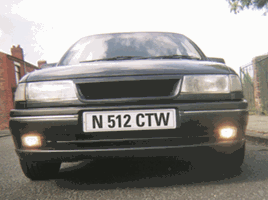
B
C
D
Correct Answer: D
Explanation: Switch off your fog lights if the weather improves, but be prepared to use them again if visibility reduces to less than 100 metres (328 feet).
Explanation: Switch off your fog lights if the weather improves, but be prepared to use them again if visibility reduces to less than 100 metres (328 feet).
Correct Answer: B
Explanation: Don't forget to switch off your fog lights when the weather improves. You could be prosecuted for driving with them on in good visibility. The high intensity of rear fog lights can dazzle following drivers and make your brake lights difficult to notice.
Explanation: Don't forget to switch off your fog lights when the weather improves. You could be prosecuted for driving with them on in good visibility. The high intensity of rear fog lights can dazzle following drivers and make your brake lights difficult to notice.
Correct Answer: A
Explanation: Rear fog lights shine more brightly than normal rear lights, so that they show up in reduced visibility. When the visibility improves, you must switch them off; this stops them dazzling the driver behind.
Explanation: Rear fog lights shine more brightly than normal rear lights, so that they show up in reduced visibility. When the visibility improves, you must switch them off; this stops them dazzling the driver behind.
Correct Answer: B
Explanation: Chains can be fitted to your wheels in snowy conditions. They can help you to move off without wheelspin, or to keep moving in deep snow. You'll still need to adjust your driving to suit these conditions.
Explanation: Chains can be fitted to your wheels in snowy conditions. They can help you to move off without wheelspin, or to keep moving in deep snow. You'll still need to adjust your driving to suit these conditions.
Correct Answer: B
Explanation: You should brake and slow down before selecting a lower gear. The gear can then be used to keep the speed low and help you control the vehicle. This is particularly helpful on long downhill stretches, where brake fade can occur if the brakes overheat.
Explanation: You should brake and slow down before selecting a lower gear. The gear can then be used to keep the speed low and help you control the vehicle. This is particularly helpful on long downhill stretches, where brake fade can occur if the brakes overheat.
30. Why could it be dangerous to keep the clutch down, or select neutral, for long periods of time while you're driving?
Mark one answer
B
C
D
Correct Answer: D
Explanation: Letting your vehicle roll or coast in neutral reduces your control over steering and braking. This can be dangerous on downhill slopes, where your vehicle could pick up speed very quickly.
Explanation: Letting your vehicle roll or coast in neutral reduces your control over steering and braking. This can be dangerous on downhill slopes, where your vehicle could pick up speed very quickly.
31. You're driving on an icy road. What distance from the car in front should you drive?
Mark one answer
B
C
D
Correct Answer: D
Explanation: Don't travel in icy or snowy weather unless your journey is essential. Drive extremely carefully when roads are or may be icy. Stopping distances can be ten times greater than on dry roads.
Explanation: Don't travel in icy or snowy weather unless your journey is essential. Drive extremely carefully when roads are or may be icy. Stopping distances can be ten times greater than on dry roads.
Correct Answer: D
Explanation: If you're driving on a motorway at night or in poor visibility, you must always use your headlights, even if the road is well lit. Other road users must be able to see you, but you should avoid causing dazzle.
Explanation: If you're driving on a motorway at night or in poor visibility, you must always use your headlights, even if the road is well lit. Other road users must be able to see you, but you should avoid causing dazzle.
33. You're on a motorway at night, with other vehicles just ahead of you. Which lights should you have on?
Mark one answer
B
C
D
Correct Answer: A
Explanation: If you're driving behind other traffic on the motorway at night, use dipped headlights. Main-beam headlights will dazzle the other drivers. Your headlights' dipped beam should fall short of the vehicle in front.
Explanation: If you're driving behind other traffic on the motorway at night, use dipped headlights. Main-beam headlights will dazzle the other drivers. Your headlights' dipped beam should fall short of the vehicle in front.
Correct Answer: A
Explanation: Having tyres correctly inflated and in good condition will ensure they have maximum grip on the road; how well your tyres grip the road has a significant effect on your car's stopping distance.
Explanation: Having tyres correctly inflated and in good condition will ensure they have maximum grip on the road; how well your tyres grip the road has a significant effect on your car's stopping distance.
B
C
D
Correct Answer: D
Explanation: Always use your headlights at night on a motorway unless you've had to stop on the hard shoulder. If you break down and have to use the hard shoulder, switch off your headlights but leave your sidelights on, so that other road users can see your vehicle.
Explanation: Always use your headlights at night on a motorway unless you've had to stop on the hard shoulder. If you break down and have to use the hard shoulder, switch off your headlights but leave your sidelights on, so that other road users can see your vehicle.
Correct Answer: B
Explanation: When you take your foot off the accelerator, engines have a natural resistance to turn, caused mainly by the cylinder compression. Changing to a lower gear requires the engine to turn faster and so it will have greater resistance than when it's made to turn more slowly. When going downhill, changing to a lower gear will therefore help to keep the vehicle's speed in check.
Explanation: When you take your foot off the accelerator, engines have a natural resistance to turn, caused mainly by the cylinder compression. Changing to a lower gear requires the engine to turn faster and so it will have greater resistance than when it's made to turn more slowly. When going downhill, changing to a lower gear will therefore help to keep the vehicle's speed in check.
37. Daytime visibility is poor but not seriously reduced. Which lights should you switch on?
Mark one answer
B
C
D
Correct Answer: A
Explanation: Only use your fog lights when visibility is seriously reduced. Use dipped headlights in poor conditions because this helps other road users to see you without the risk of causing dazzle.
Explanation: Only use your fog lights when visibility is seriously reduced. Use dipped headlights in poor conditions because this helps other road users to see you without the risk of causing dazzle.
Correct Answer: A
Explanation: Rear fog lights make it easier to spot a vehicle ahead in foggy conditions. Avoid the temptation to use other vehicles' lights as a guide, as they may give you a false sense of security.
Explanation: Rear fog lights make it easier to spot a vehicle ahead in foggy conditions. Avoid the temptation to use other vehicles' lights as a guide, as they may give you a false sense of security.
39. While you're driving in fog, it becomes necessary to use front fog lights. What should you remember?
Mark one answer
B
C
D
Correct Answer: D
Explanation: It's illegal to use your fog lights in conditions other than when visibility is seriously reduced; that is, less than 100 metres (328 feet). Fog lights are very bright and, if you use them when visibility has improved, you could dazzle other drivers.
Explanation: It's illegal to use your fog lights in conditions other than when visibility is seriously reduced; that is, less than 100 metres (328 feet). Fog lights are very bright and, if you use them when visibility has improved, you could dazzle other drivers.
Correct Answer: A
Explanation: Consider whether the increased risk is worth it. If the weather conditions are bad and your journey isn't essential, then don't drive.
Explanation: Consider whether the increased risk is worth it. If the weather conditions are bad and your journey isn't essential, then don't drive.
B
C
D
Correct Answer: D
Explanation: This is more likely to happen on vehicles fitted with drum brakes, but it can apply to disc brakes as well. Using a lower gear will assist the braking and help you to keep control of your vehicle.
Explanation: This is more likely to happen on vehicles fitted with drum brakes, but it can apply to disc brakes as well. Using a lower gear will assist the braking and help you to keep control of your vehicle.
Correct Answer: B
Explanation: If you have to drive in fog, switch your dipped-beam headlights on and keep your windscreen clear. You should always be able to pull up within the distance you can see ahead.
Explanation: If you have to drive in fog, switch your dipped-beam headlights on and keep your windscreen clear. You should always be able to pull up within the distance you can see ahead.
43. You've just driven out of fog. What must you do now that visibility has improved?
Mark one answer
B
C
D
Correct Answer: D
Explanation: You must turn off your fog lights if visibility is more than 100 metres (328 feet). Be prepared for the fact that the fog may be patchy and you may need to turn them on again if the fog returns.
Explanation: You must turn off your fog lights if visibility is more than 100 metres (328 feet). Be prepared for the fact that the fog may be patchy and you may need to turn them on again if the fog returns.
Correct Answer: D
Explanation: If your rear fog lights are left on when it isn't foggy, the glare they cause makes it difficult for road users behind to know whether you're braking or you've just forgotten to turn off your rear fog lights. This can be a particular problem on wet roads and on motorways. If you leave your rear fog lights on at night, road users behind you are likely to be dazzled and this could put them at risk.
Explanation: If your rear fog lights are left on when it isn't foggy, the glare they cause makes it difficult for road users behind to know whether you're braking or you've just forgotten to turn off your rear fog lights. This can be a particular problem on wet roads and on motorways. If you leave your rear fog lights on at night, road users behind you are likely to be dazzled and this could put them at risk.
45. What will happen if you hold the clutch pedal down or roll in neutral for too long?
Mark one answer
B
C
D
Correct Answer: C
Explanation: Holding the clutch down or staying in neutral for too long will cause your vehicle to freewheel. This is known as 'coasting' and it's dangerous because it reduces your control of the vehicle.
Explanation: Holding the clutch down or staying in neutral for too long will cause your vehicle to freewheel. This is known as 'coasting' and it's dangerous because it reduces your control of the vehicle.
46. You're driving down a steep hill. Why could it be dangerous to keep the clutch down or roll in neutral for too long?
Mark one answer
B
C
D
Correct Answer: D
Explanation: Driving in neutral or with the clutch down for long periods is known as 'coasting'. There will be no engine braking and your vehicle will pick up speed on downhill slopes. Coasting can be very dangerous because it reduces steering and braking control.
Explanation: Driving in neutral or with the clutch down for long periods is known as 'coasting'. There will be no engine braking and your vehicle will pick up speed on downhill slopes. Coasting can be very dangerous because it reduces steering and braking control.
Correct Answer: D
Explanation: Coasting is when you allow the vehicle to freewheel in neutral or with the clutch pedal depressed. Speed will increase as you lose the benefits of engine braking and have less control. You shouldn't coast, especially when approaching hazards such as junctions or bends and when travelling downhill.
Explanation: Coasting is when you allow the vehicle to freewheel in neutral or with the clutch pedal depressed. Speed will increase as you lose the benefits of engine braking and have less control. You shouldn't coast, especially when approaching hazards such as junctions or bends and when travelling downhill.
Correct Answer: D
Explanation: In normal conditions, a ford can be crossed quite safely by driving through it slowly. The water may affect your brakes, so when you're clear of the ford, test them before you resume normal driving.
Explanation: In normal conditions, a ford can be crossed quite safely by driving through it slowly. The water may affect your brakes, so when you're clear of the ford, test them before you resume normal driving.
Correct Answer: D
Explanation: Try to look ahead and read the road. Plan your approach to junctions and select the correct gear in good time. This will give you the control you need to deal with any hazards that occur. You'll coast a little every time you change gear. This can't be avoided, but it should be kept to a minimum.
Explanation: Try to look ahead and read the road. Plan your approach to junctions and select the correct gear in good time. This will give you the control you need to deal with any hazards that occur. You'll coast a little every time you change gear. This can't be avoided, but it should be kept to a minimum.
Correct Answer: B
Explanation: You must use dipped headlights when daytime visibility is seriously reduced, generally to 100 metres (328 feet) or less. You may also use front or rear fog lights, but they must be switched off when visibility improves.
Explanation: You must use dipped headlights when daytime visibility is seriously reduced, generally to 100 metres (328 feet) or less. You may also use front or rear fog lights, but they must be switched off when visibility improves.
51. You're braking on a wet road. Your vehicle begins to skid. It doesn't have anti-lock brakes. What's the first thing you should do?
Mark one answer
B
C
D
Correct Answer: D
Explanation: If the skid has been caused by braking too hard for the conditions, release the brake. You may then need to reapply and release the brake again. You may need to do this a number of times. This will allow the wheels to turn and so some steering should also be possible.
Explanation: If the skid has been caused by braking too hard for the conditions, release the brake. You may then need to reapply and release the brake again. You may need to do this a number of times. This will allow the wheels to turn and so some steering should also be possible.



